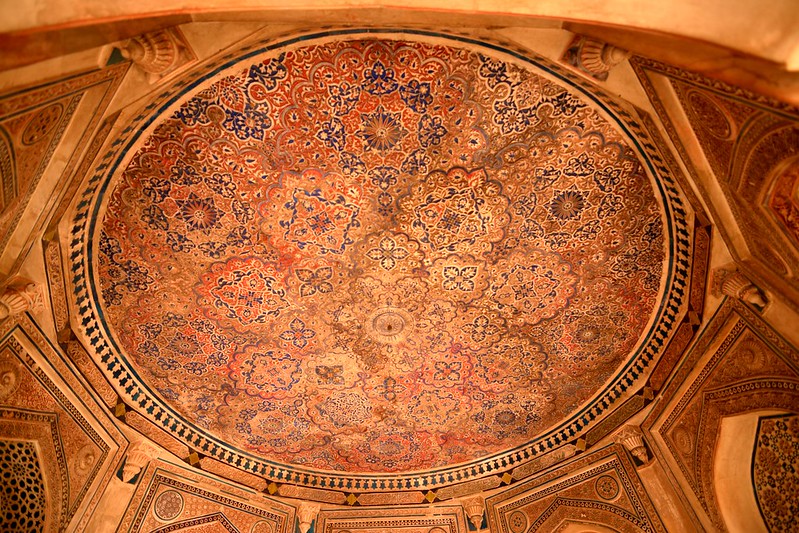Maharashtra, a state that beautifully blends spirituality, culture, and history, is home to some of the most revered Jyotirlinga temples in India. Jyotirlingas are sacred shrines dedicated to Lord Shiva, and visiting these divine sites is an enriching spiritual experience. There are around 12 Jyotirlinga temples spread across the whole of India. Out of these 5 are in Maharashtra alone.
What is a Jyotirlinga?
A Jyotirlinga is a sacred symbol representing Lord Shiva, often worshipped as a manifestation of the divine light of Shiva. The word “Jyoti” means light, and “Linga” refers to the symbolic representation of Lord Shiva. According to Hindu mythology, these twelve Jyotirlingas are believed to be the places where Lord Shiva appeared as a column of light, without beginning or end. These shrines are considered highly powerful and are an important part of the spiritual journey for devotees
Importance and History of Jyotirlingas in Maharashtra
The Jyotirlingas in Maharashtra are not only significant for their spiritual importance but also for their rich history. They are believed to be the places where Lord Shiva manifested himself in the form of a pillar of light, which is why they are referred to as “Jyotirlingas” (meaning “light of Lord Shiva”). Devotees believe that visiting these temples will help them purify their soul and gain divine blessings.
Jyotirlinga Pilgrimage in Maharashtra
The Jyotirlinga pilgrimage in Maharashtra is an awe-inspiring journey for those seeking solace, peace, and spiritual awakening. Each of these temples has its own unique history and story associated with Lord Shiva, and they are places where you can experience a deep sense of connection with the divine.
How Many Jyotirlingas Are There in Maharashtra?
Maharashtra is home to a total of five Jyotirlingas: Trimbakeshwar, Grishneshwar, Bhimashankar, Aundha Nagnath, and Vaijnath. These temples are spread across the state and offer a range of experiences, from tranquil mountain retreats to coastal shrines.
If you’re planning a spiritual journey or looking to explore the historical significance of these temples, here’s a guide to the 5 must-visit Jyotirlingas in Maharashtra.
1. Trimbakeshwar Jyotirlinga Temple(Nashik)
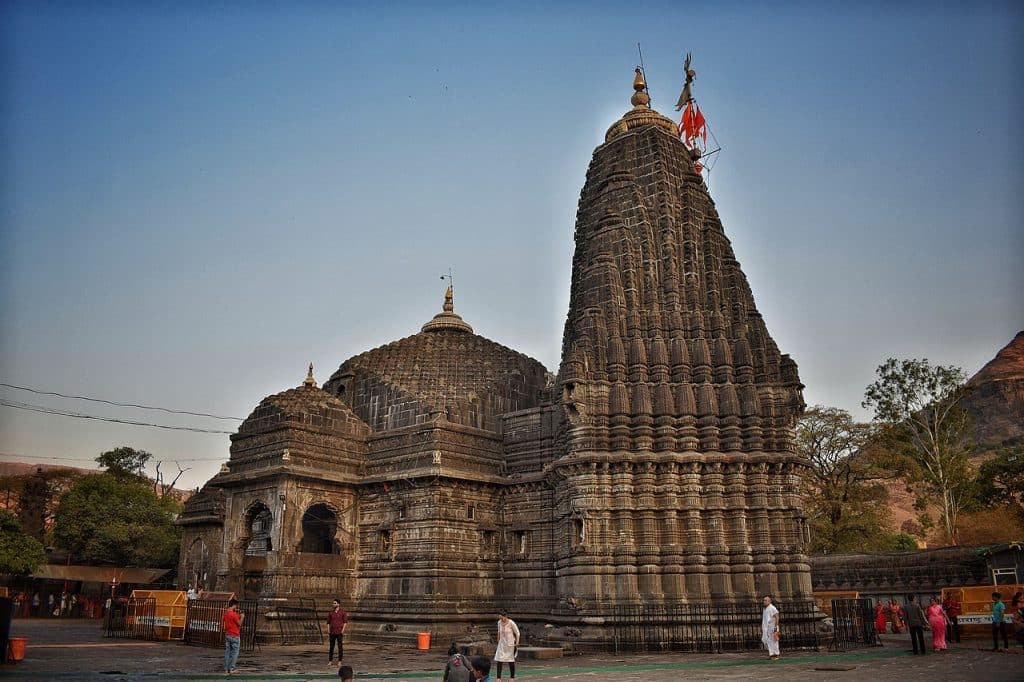
Located in the picturesque town of Trimbak, about 28 km from Nashik, Trimbakeshwar is one of the most sacred Jyotirlingas in Maharashtra. The temple is believed to be where Lord Shiva manifested in the form of a radiant light, symbolizing the eternal cosmic energy. The Trimbakeshwar Jyotirlinga temple is known for its historical and religious significance. The Shiva Linga of Trimbakeshwar temple has three faces representing the three supreme deities of the Hindu pantheon- Brahma, Vishnu and Maheshwar. The river Godavari originates here and the temple is also one the sites of the Kumbh Mela that takes place every 12 years ( the next kumbh mela is scheduled to take place here in 2027) ; it is believed that anyone who visits the temple will attain salvation.
- Temple Timings: 5:30 am -9:00 pm.
- How to reach: The nearest airport and railway station is in Nashik (42 kms), and Trimbak is well connected by road.
- Best time to visit: The months from October to March are ideal for a visit.
- Accommodation: There are various guest houses and hotels in Nashik offering comfortable stay options.
- Attractions in and around Trimbakeshwar temple
- Brahmagiri Hills
- Shri Navshya Ganpati
- Sita Gufa
- Kalaram temple
- Dugarwadi Waterfalls
- Ramkund
- Pandavleni Caves
- Saptashrungi Temple
- Panchavati
- Harihar Fort
2.Grishneshwar Jyotirlinga Temple (Aurangabad)
Grishneshwar Temple is one of the five Jyotirlingas in Maharashtra, adding to its spiritual and cultural importance. It is not only a revered pilgrimage site but also a remarkable example of medieval Indian architecture. Situated near the famous Ellora Caves, the temple attracts both religious devotees and history enthusiasts alike, as its proximity to the caves adds to its appeal for those interested in historical and cultural tourism.
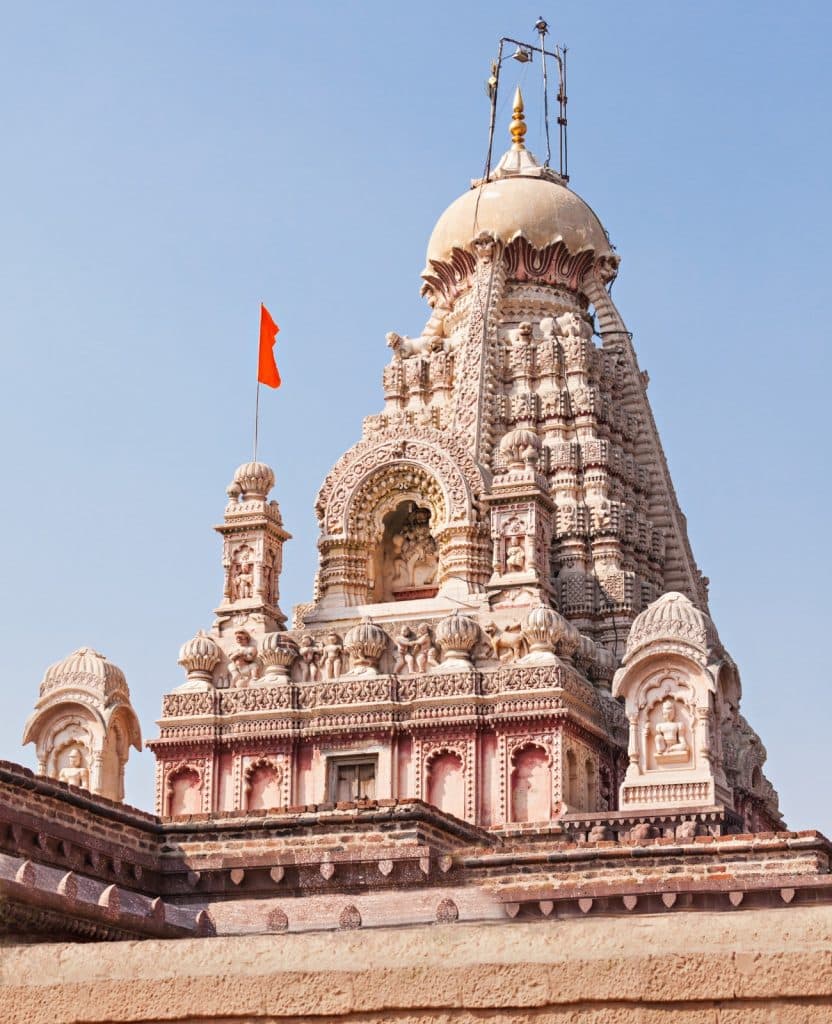
As the 12th Jyotirlinga, Grishneshwar holds a special place in the hearts of devotees. Many believe that a visit to this temple completes the Jyotirlinga pilgrimage, offering the benefits of worshiping at all 12 sacred sites. Devotees find solace from personal struggles through the powerful Grishneshwar Jyotirlinga Darshan.
Located in Verul village, about 20 km from Daulatabad near Aurangabad, the temple is situated on the banks of an ancient pond called ‘Shivalay.’ One unique aspect of the Grishneshwar Temple is the design of the Lingam, where the water used during the Abhishekam ritual flows toward the east, adding special significance to the worship experience. Witnessing this during the temple rituals is a powerful and spiritually enriching experience for many devotees.
Besides its religious significance, the Grishneshwar Temple built primarily with red volcanic rock is also renowned for its exquisite carvings and sculptures that adorn its walls and pillars. A testament to the craftsmanship of medieval Indian craftsmen, the temple stands out for its distinctive appearance and architectural brilliance.
The temple’s historical significance is further enriched by its association with Ahilyabai Holkar, a revered queen of the Maratha Empire. She is credited with commissioning the reconstruction of the Grishneshwar Temple, restoring it to its former glory and making it a vital pilgrimage destination for Lord Shiva devotees.
- Temple Timings: 5:30 am -9:00 pm.
- How to reach: The nearest railway station is Aurangabad, and the temple is well connected via road.
- Best time to visit: October to February is the best time to visit due to pleasant weather.
- Accommodation: You can find numerous hotels and resorts in Aurangabad for a comfortable stay.
- Attractions in and around Grishneshwar Jyotirlinga temple
- Ajanta and Ellora Caves
- Bhadra Maruti Temple
- Chhatrapati Sambhaji Nagar Caves
- Devgiri Fort
- Bibi ka Maqbara (Replica of the Taj Mahal)
3. Bhimashankar Jyotirlinga Temple(Pune)
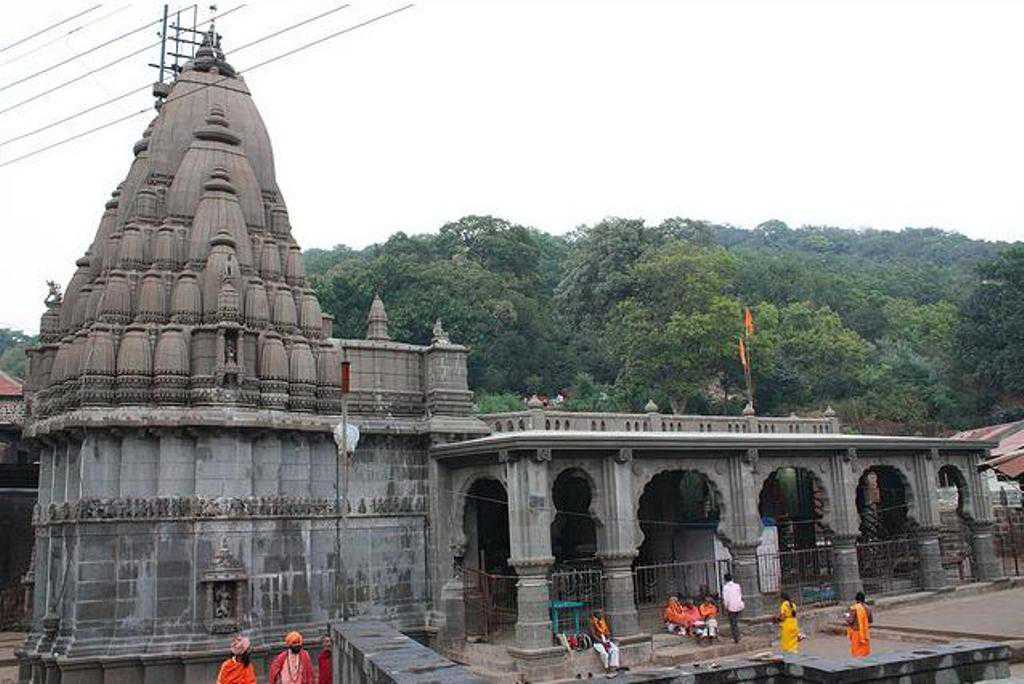
Bhimashankar, situated around 50 km from Pune, is one of Maharashtra’s most venerated Jyotirlingas. Here, Lord Shiva is worshipped in the form of Ardhanareeshwara, a divine representation that symbolizes the union of the masculine and feminine energies. Devotees visiting the temple often take a dip in the nearby Bhima River, which is believed to wash away their sins and cleanese the souls. Legend states the river originated from Lord Shiva’s sweat during his battle with the demon Tripurasura, further enhancing its sanctity.
Architecturally, the temple’s architectural style is a captivating blend of ancient and contemporary elements, reflecting centuries of design evolution. The older parts of the temple exhibit classic Nagara-style architecture with intricate carvings and sculptures, reflecting ancient craftsmanship, while the newer sections feature more contemporary designs.
Beyond its religious importance, Bhimashankar is recognized as a biodiversity hotspot and is protected as a wildlife sanctuary. This sanctuary is home to diverse flora and fauna, including the Indian Giant Squirrel- the state animal of Maharashtra. This lush forests and abundant wildlife make Bhimashankar a destination for both spiritual seekers and nature enthusiasts. Devotees can experience a unique combination of Jyotirlinga darshan and exploration of the natural beauty of the Bhimashankar Wildlife Sanctuary.
- Temple Timings: 4:30 am-3:15 pm & 4:00 pm -9:30 pm
- How to reach: Pune is the nearest major city, with well-connected roads to Bhimashankar.
- Best time to visit: September to March is considered the best time to visit, as the weather is more pleasant.
- Accommodation: There are several hotels and lodges in Pune and near Bhimashankar for accommodation.
- Attractions in and around Bhimashankar Jyotirlinga Temple
- Datta Mandir
- Ram Mandir
- Hanuman Lake
- Ahupe Waterfalls
- Bhimashankar Fort
4. Aundha Nagnath Jyotirlinga Temple(Hingoli)
This temple is particularly significant among Shiva devotees due to the belief that worshiping Lord Nagnath here can protect one from all types of poisons. What makes the temple even more intriguing is the unique design of its sanctum – it is located underground, and devotees must descend into the basement to worship Lord Nagnath. This distinctive feature adds a sense of mystery and spiritual depth to the experience.
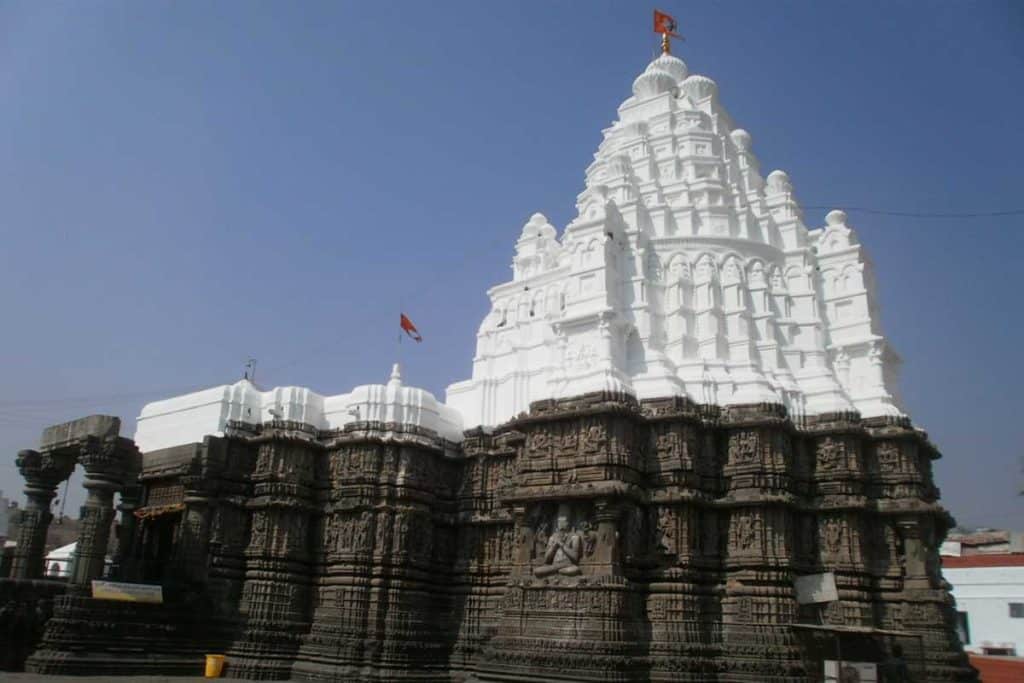
Spanning an impressive 60,000 square feet, the Aundha Nagnath Temple is a shining example of architectural fusion. A combination of Hemadpanthi & Yadava architectural style its exquisite carvings and elaborate sculptures make the temple not only visually captivating but also historically significant, offering a glimpse into the artistry and architectural prowess of ancient India.
- Temple Timings: 4:00 am-9:00 pm
- How to reach: Hingoli is easily accessible by road, and the temple is a short drive away. The nearest railway station is Hingoli (26 kms)followed by Parbhani(52 kms) while Nanded at 65 kms is the nearest airport.
- Best time to visit: The months between November and March are ideal.
- Accommodation: You can stay in Nashik, where numerous hotels and guesthouses are available.
- Attractions in and around Aundha Nagnath Jyotirlinga Temple
- Tulaja Devi Sansthan Temple
- Siddheshwar Dam
- Mallinath Digambar Jain Temple
5. Sri Vaijnath Temple (Parli, Bheed )
The Sri Vaijnath Temple, also known as the Shri Vaidyanatha Temple, is located in Parli Vaijnath in the Beed district of Maharashtra. Estimated to be around 3000 years old, this ancient temple is one of the 12 Jyotirlingas dedicated to Lord Shiva. Surrounded by mountains and dense forests rich in medicinal and healing plants, the temple is renowned for its association with Lord Vaidhyanath, believed to possess healing powers. Devotees often touch the Shiva Lingam during worship, as it is thought to aid in healing and provide various health benefits.
One unique aspect of the temple is that during the Abhishekam ritual, male devotees are not allowed to wear clothes above the waist. The temple, standing approximately 75-80 feet high, features a main entrance with a brass-plated door on the east side. Renovated in 1706 by the Maratha queen Ahilyabai Holkar, the temple holds historical significance.
Surrounded by four strong walls, the Sri Vaijnath Temple includes corridors and a courtyard, accessible via a wide staircase. It is known for its beautiful carvings and sculptures that depict various stories and legends from Hindu mythology, serving as a testament to the artistic skill of its craftsmen. This significant pilgrimage site for devotees of Lord Shiva offers a serene and spiritually enriching experience.
- Temple Timings: 5:00 am-9:00 pm
- How to reach: The nearest railway station is Parli (3 kms) while Aurangabad at 140 kms is the nearest airport.
- Best time to visit: October to March, as the weather is cooler and pleasant.
- Accommodation: A variety of accommodation options, from guesthouses to budget stays are available.
- Attractions in and around Aundha Nagnath Jyotirlinga Temple
- Dakshin Mukhi Ganesh Temple
- Shri Someshwar Mahadev Temple
- Shri Ratneshwar Mahadev Temple
A visit to the Jyotirlingas in Maharashtra is a deeply spiritual and transformative experience. Whether you are a devotee or a traveler seeking to explore the cultural heritage of the state, a Jyotirlinga tour of Maharashtra is sure to leave a lasting impact. Each temple not only offers a connection to Lord Shiva but also a window into the rich history, mythology, and architectural brilliance of the region.
So, if you’re planning a journey to explore the divine energy of Lord Shiva, make sure you include these 5 Jyotirlingas in your itinerary. It promises to be an unforgettable pilgrimage full of devotion, peace, and spiritual growth.





